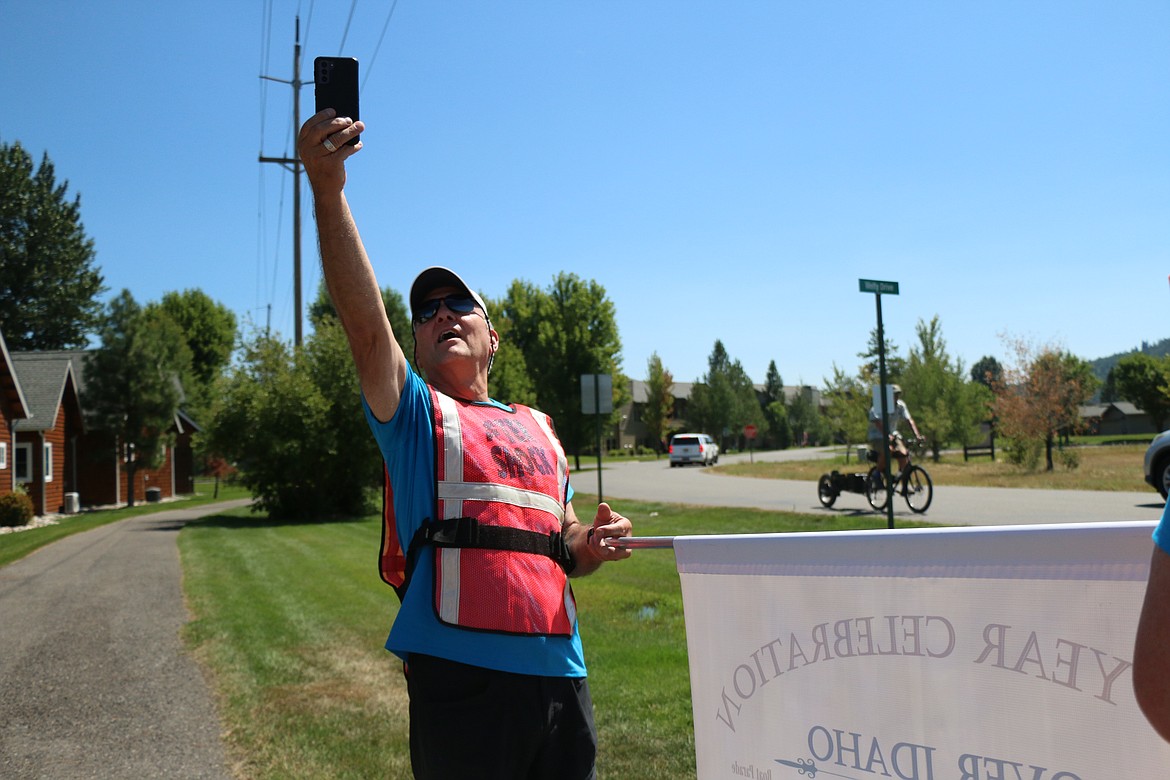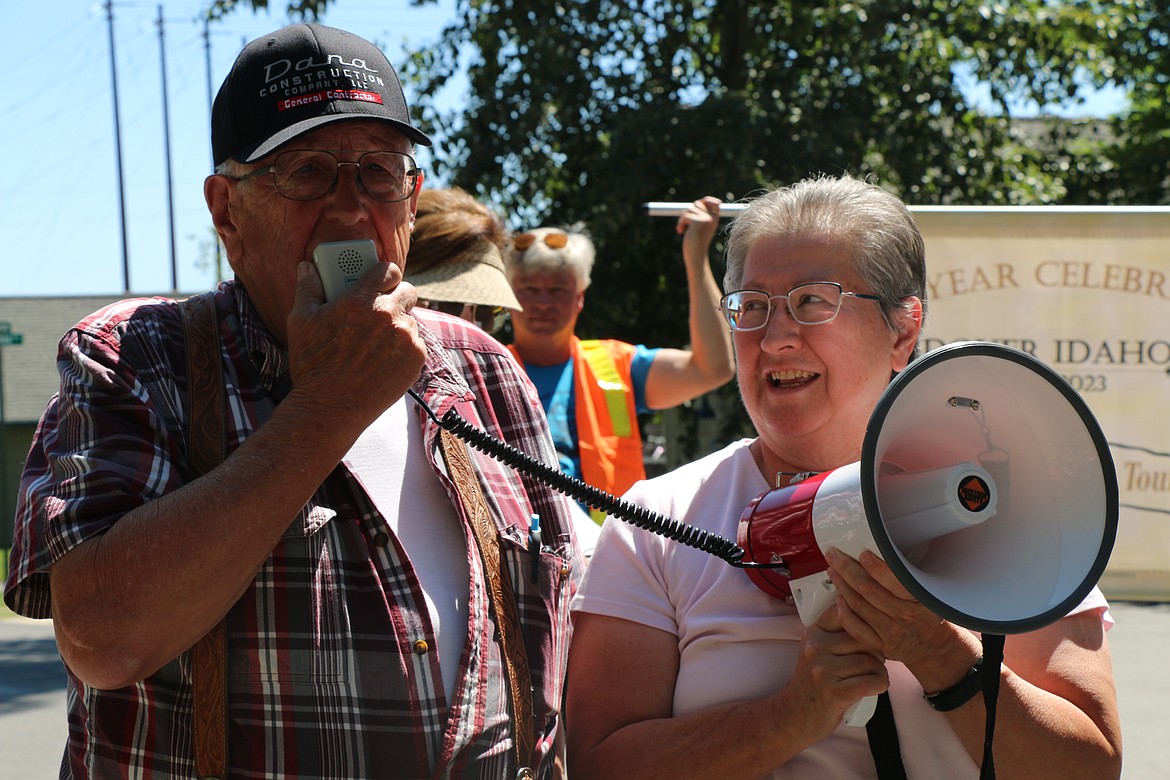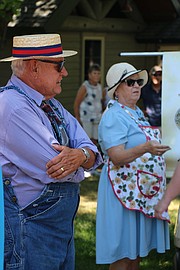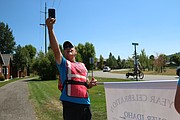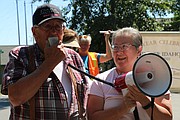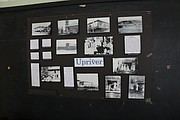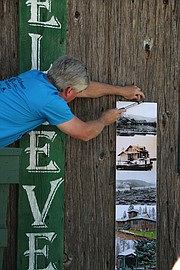'Dover was the best place to grow up'
DOVER — Rene Ames remembers moving to Dover after marrying her husband, Jack, in 1951.
Married 70 years until his passing, she recalled raising their children in Dover, watching them grow up, and seeing them ride horses and swim in the lake nearby. Neighbors watched out for each other, and Dover was a magical place to live — and still is, Ames said.
The longtime Dover resident was just one of those who spoke during Saturday's centennial walk held to mark the community's centennial. The celebration marked roughly 100 years since the Dover Community Church and just over four dozen homes were barged upriver from Laclede.
Also held during the celebration was a boat parade starting in Laclede and ending at Dover. About 15 boats took part in a parade from Laclede to Dover, traveling the route of the homes and church, then A.C. White's rustic summer cabin, when they were barged upriver after the mill owner made the decision.
More than 100 community members, residents, and officials gathered for the historic walk, starting at Dover City Hall in the Dover Bay area of the city and ending at Dover Community Church on historic Washington Street, where many of the barged homes ended up.
In addition, a community barbecue was held with music, dancing, and exhibits in the Dover Community Church and Dover Community Hall, both historic buildings.
"The celebration brought the community together," Dover Mayor George Eskridge said. "Everybody had a lot of fun. Everybody worked hard to make this a success, and it was a success beyond all expectation."
Some who took part in the walk recalled riding horses to the beach in the summer and hooking them to sleds in the winter. Others recalled heading to the town's two bluffs to jump off into the cool waters of Lake Pend Oreille on hot summer days. Still others remembered the former president of the Dover Lumber Company, who had no children of his own, buying Christmas gifts for every child in the community each year.
Eskridge recalled a friend borrowing lumber from the nearby mill and building the "first condominium in Dover" that "kept the sun out and the rain in." Another recalled walking along the bluff on Tank Hill with family and looking down after their husband said some of the town's kids were skinny-dipping. When she looked down, she realized at least one of those kids was hers.
"Dover was the best place to grow up," said one woman. "It truly was."
Two major milestones bookend the community's history, Eskridge said. The first was the floating upriver of the historic church, some 50-odd homes, and other buildings. The second was the development of Dover Bay on the old mill site. Both are paramount to the city's history and worthy of celebration, Eskridge said.
The first launched the community, and the second brought new life, making Dover a unique community with walking trails, bike paths, and a growing economic base.
"Dover is so good that now I relate to Sandpoint as being a suburb of Dover," Eskridge told those gathered for the walk, tongue firmly in cheek. "I've taken every occasion to make that known in Boise, especially in the meeting I was at last week for several legislators. I try not to let them forget it and appreciate what they've got with Dover."
The first mention of the Pend Oreille River, on whose banks Dover sits, was in 1809, when explorer, fur trader, and mapmaker David Thompson made his first trip down the river. Those documents are the first known historical documents on the Kalispel Tribe, walk organizer Sue Bache said.
However, it wasn't until 1883, when the Northern Pacific Railroad built a track on the north side of the river, that communities like Dover and Laclede began. In 1906, Dr. O.S. Welty and several investors purchased the land on which Dover now sits and started a mill. Originally named Welty, the town's name was changed to Dover in 1910 to honor the residents' collective roots in Canal Dover, Ohio.
Downriver, A.C. White would purchase land three years later and start his own mill after moving from Michigan. The site quickly grew to include a mill, a planer, a large sash and door factory, and blocks of employee housing.
However, in August 1922 — two years after the Dover mill closed and 13 years after his mill opened — a devastating fire broke out at White's Laclede facility, burning the mill to the ground and taking with it an estimated 1 million board feet of manufactured Western white pine of the finest grade, Bache said.
"The Pend d'Oreille Review noted that it was the worst single fire in the history of Bonner County," Bache told those gathered for the walk at the first stop. "This tragedy will come to have a profound influence on the early formation of Dover, as well as the significance of many of its historic buildings."
After debating what to do — rebuild the mill in Laclede and barge what he could salvage upriver to Dover, and take over Welty's mill. A few weeks after the fire, White made his decision — he would move his operations northeast to Dover.
"Our great fire loss on Aug. 17 was a heavy blow," A.C. White said in making the announcement, Bache said, citing a report in a local newspaper.
However, with orders to fill from the Midwest to the East Coast, the tour organizer said reports noted that White was under pressure to get back in operation as soon as possible.
"White quickly made plans to completely renovate and expand the idle Dover mill here," Bache told the crowd. "Dover was abuzz with the activity of remodeling the mill, building dry kilns, and building a new sash and door factory, which would be the largest in the area and the only one in North Idaho."
Plans were made to move the buildings upriver to Dover — noted in the American Lumbermen publication as an "industrial feat of the first magnitude, she told the crowd, adding the move was a complete success.
"Local papers reported that not even the plaster on the walls was damaged, and before the houses could be let down off the deck, smoke was seen coming out of the chimneys," she said. "Local newspapers report that a building a day was barged upriver, with White's eight-room summer cottage the last to be moved, taking place almost exactly 100 years ago."
Created just over a year ago, the Dover Historical Committee is the group behind the centennial celebration. It's the second dive into the community's history, with the first being a booklet, "Dover Roads and Landmarks," which detailed many of the community's original families.
Being a part of the celebration meant a great deal, Eskridge said, both because he grew up in Dover and because it drew the entire community together.
"One of my objectives as mayor is to bring the community together and realize we're all Doverites," he said. "We're not old Dover. We're not new Dover. We're just one town called Dover, and it's just a great place to live and to raise your families."



